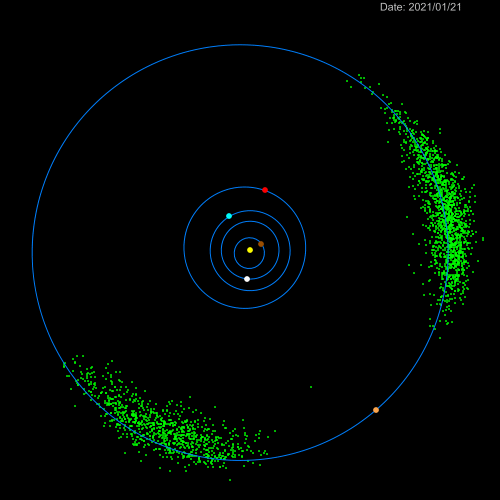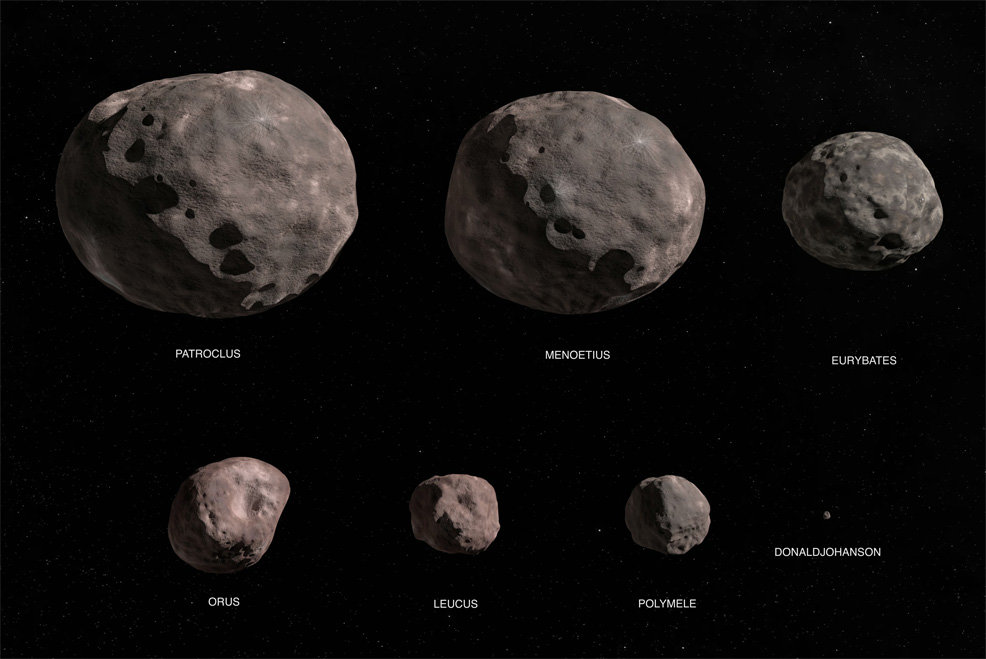
16th October 2021 Lucy begins 12-year mission to Trojan asteroids NASA has launched the first ever spacecraft to visit Jupiter's Trojan asteroids. The Lucy mission successfully blasted off at 5:34 a.m. EDT (9:34 a.m. UCT) this morning on a United Launch Alliance (ULA) Atlas V rocket from Space Launch Complex 41 at Cape Canaveral, Florida. An hour later, it returned its first signal to Earth, sent from its own antenna to NASA's Deep Space Network. Lucy is now travelling at 108,000 kph (67,000 mph) on a trajectory that will orbit the Sun and bring it back toward Earth in October 2022 for a gravity assist. Over the next 12 years, it will fly past a total of seven different asteroids – a main belt asteroid, along with six Jupiter Trojans. The latter type are asteroids that share Jupiter's orbit around the Sun, orbiting either ahead of or behind the gas giant.
The probe is named after Lucy, a fossilised skeleton of Australopithecus afarensis, one of our earliest known hominin ancestors. This specimen, discovered in Ethiopia in 1974, changed our understanding of human origins and evolution. Scientific evidence indicates that Trojan asteroids are remnants of the material that formed giant planets. Studying them could reveal previously unknown information about their formation and our Solar System's evolution – in the same way that the fossilised skeleton of Lucy revolutionised our understanding of human evolution. Lucy's complex path will take it to both clusters of Trojans highlighted in the animation above. It will provide close-up views of all three major types of bodies in the swarms (so-called C-, D- and P-types). The C-types are found mostly in the outer parts of the Main Belt asteroids, which lie between Mars and Jupiter. The D- and P-type Trojans, dark red in colour, resemble those found in the Kuiper Belt that extends beyond the orbit of Neptune. All of the Trojans are thought to be abundant in dark carbon compounds. Below an insulating blanket of dust, they are probably rich in water and other volatile substances. No other spacecraft in history has been launched to as many different destinations in independent orbits around the Sun. It is hoped that Lucy will show, for the first time, the diversity of the primordial bodies that built the planets.
"We started working on the Lucy mission concept early in 2014, so this launch has been long in the making," said Hal Levison, Lucy principal investigator and a scientist at the Southwest Research Institute, Texas. "It will still be several years before we get to the first Trojan asteroid, but these objects are worth the wait and all the effort because of their immense scientific value. They are like diamonds in the sky." The probe's first Earth gravity assist in 2022 will accelerate and direct its trajectory beyond the orbit of Mars. The spacecraft will then swing back toward Earth for another gravity assist in 2024. This will propel Lucy toward the Donaldjohanson asteroid – located within the Solar System's main asteroid belt – in 2025. Lucy will then journey towards its first Trojan encounter in the swarm ahead of Jupiter for a 2027 arrival. After completing its four targeted flybys, it will travel back to Earth for a third gravity boost in 2031, catapulting it to the trailing swarm of Trojans in 2033. Lucy's final two targets will be its largest, a pair of binary asteroids called Patroclus and Menoetius, estimated at 113 km (70 mi) and 104 km (65 mi) in diameter, respectively. The mission may not end there, however. "What's amazing about this trajectory is that we can continue to do loops through the swarms, as long as the spacecraft is healthy," said Coralie Adam from KinetX Aerospace, which is providing navigation support to the project. "And so, after the final encounter with Patroclus and Menoetius, we plan to propose to NASA to do an extended mission to explore more Trojans."
Comments »
If you enjoyed this article, please consider sharing it:
|








